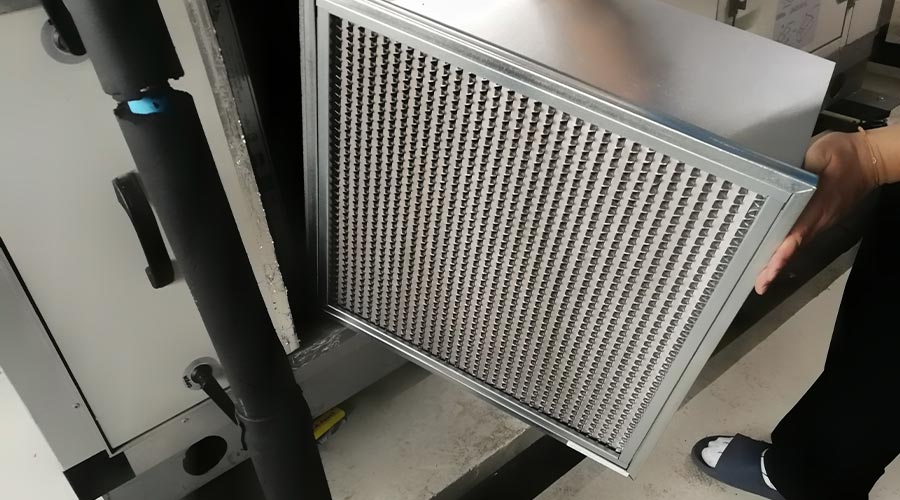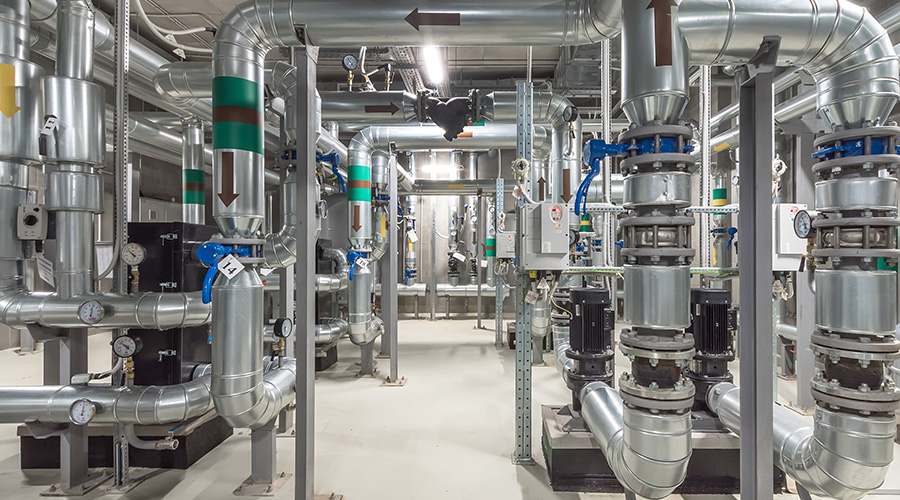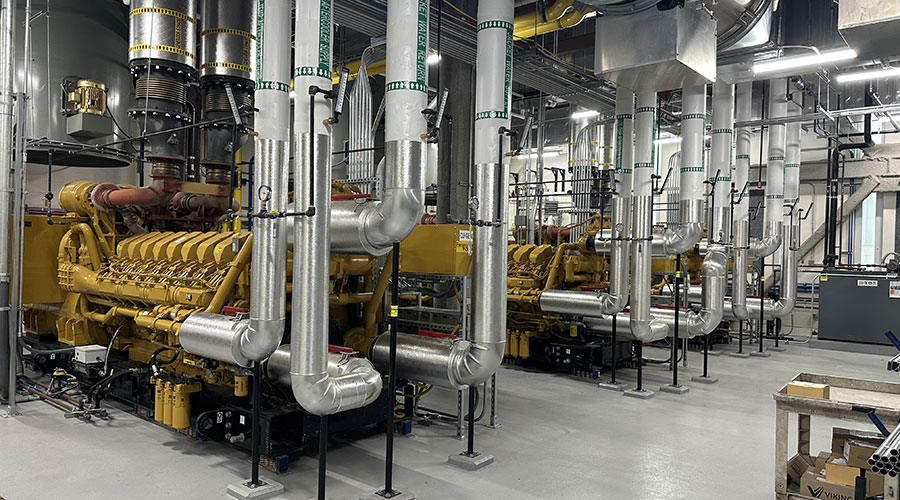Fresh Air: New HVAC Approaches
Building owners are looking closely at a range of innovations as the marketplace demands change
The entire HVAC industry is re-examining itself. Code compliance, environmental concerns, cost issues, developments in technology and equipment — these are among the key factors driving changes in HVAC designs. In many cases, tried-and-true solutions are falling by the wayside, replaced by innovative approaches to old problems.
One big reason for new strategies is changes in codes. As ASHRAE 90.1 is adopted by building codes, new requirements will ripple through the industry. The latest version of ASHRAE 90.1 adds requirements for equipment efficiencies, building envelope design, daylighting strategies and duct construction. Allowable transport factors dictate duct sizing criteria and control strategies. Many of these new requirements require examination of long-held assumptions about the way buildings are designed and commissioned.
Another big driver of change is the growing demand for “green” buildings that require less energy to construct and operate. Many organizations today are interested in designing their buildings to be LEED (Leadership in Energy and Environmental Design) certified, a designation developed by the U.S. Green Building Council that awards points for energy efficient design and enhanced environmental performance features. Higher levels of distinction are achieved based on the points accrued. These criteria are leading some owners away from the traditional strategies of achieving the lowest cost for design and construction efforts and moving them towards arrangements where owners work with design professionals to optimize energy efficiency and conservation, improve indoor air quality and recycle natural resources wherever possible.
Similarly, owners are more involved than ever with the design of buildings. More and more owners have their own standards and preferences that must be applied and incorporated into the design.
Today’s designs must take into account not only first and operating costs, but also the uncertainty of unregulated utility charges, long-term capital spending schemes — even the effects of an energy provider coming on site to provide electricity, heating or cooling. The entire project team must be vigilant to make sure that the right questions are being asked and to avoid costly detours.
As some of the underlying forces shaping HVAC systems have changed, so have practices in HVAC design. Several of these innovations represent a departure from conventional wisdom, while others are simply a result of the current industry environment. Here’ a look at nine emerging changes.
1. Reclamation/Conservation
Many organizations are looking at reclamation and conservation as methods of preserving natural resources. For example, organizations are currently recovering condensate from air handling unit cooling coils and using the excess water for cooling towers; this practice significantly reduces the load for domestic water on a given day. Owners are also reclaiming energy by putting in energy recovery devices to preheat or precool the supply airstream with the energy from the exhaust or relief airstream.
2. Fast Track Projects
In industry sectors such as pharmaceutical facilities, data centers, and corporate office buildings, the traditional sequence of design, bid and build for constructing buildings is becoming a thing of the past. For these segments of the industry, fast-track construction is no longer an anomaly; it is the model. Projects routinely have early packages, pre-purchase packages and multiple bid packages issued in conjunction with the development of the design. Designing for flexibility and anticipating evolution of the project design are key in minimizing costly changes during construction.
3. Ventilation Control
One method of reducing first costs and energy costs for an HVAC system is to reduce the amount of outdoor air that must be conditioned. In facilities such as laboratories, where hazardous elements are present, the challenge is reducing the volume of outside air while still maintaining code compliance, indoor air quality and safe conditions for occupants.
The installation of carbon dioxide monitoring in HVAC systems as a means of safely reducing occupant ventilation rates is gaining popularity. In this arrangement, the level of CO2 is continuously monitored on the return side of the HVAC system. Outdoor air is introduced as needed to maintain the CO2 below preset limits. This application has particular value when applied to conference areas that typically experience great shifts in the number of occupants.
A big energy user in laboratories is typically the fume hood, where all of the air that flows through the hood is exhausted outdoors. Traditionally, the common method of reducing this flow is to apply variable air volume (VAV) controls to the hood so that the amount of airflow drawn through the hood is regulated in proportion to the amount of open “sash” area. To enhance energy savings, occupancy sensor controls have been added to the hoods to further reduce flows when the sashes are left open and the hood is left unoccupied.
A recent development is “low flow” fume hoods, which claim to provide safe operating conditions for the user while requiring less airflow through the open sash areas.
4. Trending Building Performance
Today’s building automation systems (BAS) provide more flexibility than ever to manage building performance. By monitoring system performance and utility use, the BAS can automatically optimize the performance of various building systems. This can take the form of simple tasks, like the resetting of discharge air temperature or static pressure setpoints when it would save energy, to optimal on-off staging of chillers and other prime movers, to providing demand-limiting capability when the electrical peak demand is approached. All of these functions help an owner operate the building more efficiently.
These methods of management will grow more important as utilities continue to modify their billing structures towards time-of-day rates, even to the point of having the BAS polling utilities for rates and making automatic operational decisions based on optimization programs.
5. Primary-Only Chilled Water Distribution
In the not-too-distant past, chiller manufacturers would recommend that the water flowing through their chillers be kept at a constant flow rate to safely operate the equipment. In central plants with more than one chiller, this often resulted in pumping schemes involving primary and secondary pumping so that the flow could be kept constant through the chiller, while flow through the distribution piping could be varied to meet the load. Most chiller plants with multiple chillers have pumping schemes based on this concept.
As chiller controls and sensors have improved, manufacturers have realized that chillers will operate properly with varying flows. The result is systems that can operate as variable-volume, primary-only pumping systems. This change has meant energy savings and first-cost savings because there are fewer pumps, controls and electrical connections. While there are circumstances that lead to primary and secondary pumping systems, more and more plants are being designed with primary-only pumping.
6. Water-Cooled Data Center Equipment
Potential equipment loads have skyrocketed for data centers, server farms and similar spaces. Spaces that may have previously been designed at 40 watts per square foot for equipment load are being designed for increasingly higher equipment densities. For example, 100 watts per square foot is not uncommon. In one instance, an organization was looking to design space for 150 watts per square foot.
These high loads are pushing the equipment manufacturers to consider providing water cooling to the racks to offset the high loads and prevent hot spots from occurring where air distribution might be restricted. This cooling method would put the cooling at the heat source where it needs to be and could be expanded to match the number of equipment racks. Interestingly enough, this would bring data center cooling full circle: Early mainframe computers were directly cooled with chilled water before computer manufacturers moved away from water-cooled to air-cooled systems.
7. Low-Temperature Air
Low-temperature air systems are becoming more popular. Supplying air at 40 to 45 degrees instead of the more conventional 55 to 57 degrees helps keep duct costs down by providing more cooling per cfm. This scheme does have some drawbacks, including avoiding “dumping” of the air out of the diffuser in some spaces. In addition, the lower temperature can cause drafts and produce low relative humidity in the space.
8. Commissioning
Commissioning is an organized, planned and documented approach to verify that the installation and performance of equipment and systems conform to the design intent. A well-executed commissioning plan verifies installations, confirms testing, executes startup and verifies system operations. Commissioning, once a rare occurrence, is evolving into a construction standard, as evidenced by the new ASHRAE energy requirements that require a level of commissioning. Some owners have embraced commissioning because they realize that a successfully executed, sound commissioning plan is key to receiving a building that is truly “ready for turnover,” with all systems started up and adjusted in compliance with the design.
9. Alliance Agreements
Some owners are moving toward establishing alliance partnerships with equipment vendors, design professionals and construction managers. These alliances produce long-term relationships and improve the design and construction process: They engender a strong team environment where all groups work toward continuous improvement by sharing information, knowledge and lessons learned.
Charles A. Rowland, PE, is director of mechanical services for Kling Lindquist, an integrated architecture, engineering, interiors and planning firm. Martin J. Wendel, Jr., PE, is an engineering design principal for Kling Lindquist.
Related Topics:











